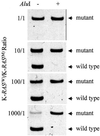Selective 'stencil'-aided pre-PCR cleavage of wild-type sequences as a novel approach to detection of mutant K-RAS
- PMID: 11522846
- PMCID: PMC55902
- DOI: 10.1093/nar/29.17.e90
Selective 'stencil'-aided pre-PCR cleavage of wild-type sequences as a novel approach to detection of mutant K-RAS
Abstract
The enriched PCR widely used for detection of mutant K-RAS in either tumor tissues or circulating DNA was modified so that abundant wild-type K-RAS alleles are cleaved prior to PCR. We took advantage of an AluI recognition site located immediately upstream of the K-RAS codon 12. The site was reconstituted upon DNA denaturation followed by annealing with a 'stencil', a 16-bp synthetic oligonucleotide complementary to the wild-type sequence. As opposed to normal K-RAS, the mutant allele forms, upon annealing with the stencil, a mismatch at the codon 12 which lies within the AluI enzyme binding site and partially inhibits its activity. The mismatch also lowers the melting temperature of the stencil-mutant K-RAS double helix as compared to stencil-wild-type duplex, so that only the latter is double stranded and selectively digested by AluI at elevated temperatures. The proposed method of stencil-aided mutation analysis (SAMA) based on selective pre-PCR elimination of wild-type sequences can be highly advantageous for detection of mutant K-RAS due to: (i) an enhanced sensitivity because of reduced competition with a great excess of normal K-RAS, and (ii) a decrease in a number of false-positive results from Taq polymerase errors. Application of SAMA for generalized detection of DNA mutations is discussed.
Figures





Similar articles
-
Detection of K-ras point mutation by enriched PCR-colorimetric plate assay.Mol Cell Probes. 1997 Feb;11(1):33-8. doi: 10.1006/mcpr.1996.0073. Mol Cell Probes. 1997. PMID: 9076712
-
Quantitative enriched PCR (QEPCR), a highly sensitive method for detection of K-ras oncogene mutation.Hum Mutat. 1997;10(4):322-5. doi: 10.1002/(SICI)1098-1004(1997)10:4<322::AID-HUMU9>3.0.CO;2-I. Hum Mutat. 1997. PMID: 9338587
-
Novel applications of polymerase chain reaction to urinary nucleic acid analysis.Methods Mol Biol. 2006;336:145-54. doi: 10.1385/1-59745-074-X:145. Methods Mol Biol. 2006. PMID: 16916260
-
K-ras oncogene activation in adenocarcinoma of the human pancreas. A study of 82 carcinomas using a combination of mutant-enriched polymerase chain reaction analysis and allele-specific oligonucleotide hybridization.Am J Pathol. 1993 Aug;143(2):545-54. Am J Pathol. 1993. PMID: 8342602 Free PMC article. Review.
-
Diagnostic detection of mutant ras genes in minor cell populations.Methods Enzymol. 1995;255:452-64. doi: 10.1016/s0076-6879(95)55047-x. Methods Enzymol. 1995. PMID: 8524131 Review. No abstract available.
Cited by
-
Restriction endonuclease-catalyzed cleavage of DNA stimulates subsequent polymerase chain reaction and enables discrimination between normal and mutant K-RAS alleles.Dokl Biochem Biophys. 2003 Nov-Dec;393:331-3. doi: 10.1023/b:dobi.0000010296.46717.35. Dokl Biochem Biophys. 2003. PMID: 14870613 No abstract available.
-
One-step detection of c-kit point mutations using peptide nucleic acid-mediated polymerase chain reaction clamping and hybridization probes.Am J Pathol. 2003 Mar;162(3):737-46. doi: 10.1016/S0002-9440(10)63870-9. Am J Pathol. 2003. PMID: 12598308 Free PMC article.
References
-
- de Kok J.B., van Solinge,W.W., Magnenat,J.-L., Ruers,T.J.M., Roelofs,R.W.H.M., van Muijen,G.N.P., Willems,J.L. and Swinkels,D.W. (1997) Detection of tumor DNA in serum of colorectal cancer patients. Scand. J. Clin. Lab. Invest., 57, 601–604. - PubMed
-
- Anker P., Mulcahy,H., Chen,X.Q. and Stroun,M. (1999) Detection of circulating tumour DNA in the blood (plasma/serum) of cancer patients. Cancer Metastasis Rev., 18, 65–73. - PubMed
-
- Chen X.Q., Stroun,M., Magnenat,J.L., Nicod,L.P., Kurt,A.M., Lyautey,J., Lederrey,C. and Anker,P. (1996) Microsatellite alterations in plasma DNA of small cell lung cancer patients. Nature Med., 2, 1033–1035. - PubMed
-
- Mulcahy H.E., Lyautey,J., Lederrey,C., Chen,X.Q., Lefort,F., Vasioukhin,V., Anker,P., Alstead,E.M., Farthing,M.J. and Stroun,M. (2000) Plasma DNA K-ras mutations in patients with gastrointestinal malignancies. Ann. N. Y. Acad. Sci., 906, 25–28. - PubMed
-
- Nawroz H., Koch,W., Anker,P., Stroun,M. and Sidransky,D. (1996) Microsatellite alterations in serum DNA of head and neck cancer patients. Nature Med., 2, 1035–1037. - PubMed
Publication types
MeSH terms
Substances
LinkOut - more resources
Full Text Sources
Research Materials
Miscellaneous

